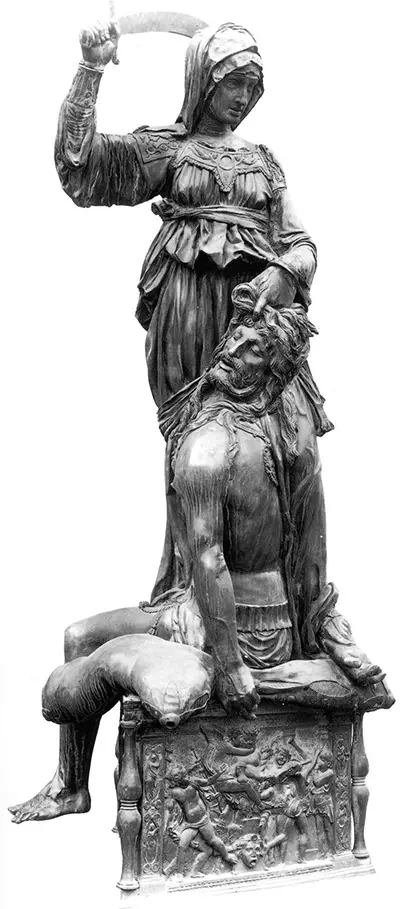Judith and Holofernes is a bronze sculpture completing by Donatello whilst at the height of his powers
The sculpture came late in his career, with it loosely dated at 1457-1464. It is highly unlikely to have taken seven years to complete so this wide date is due to a lack of supporting documentation from around that time.
Despite the lack of background information available on this sculpture we are still able to tell quite a lot about its inception. It was originally gilded, with some still remaining on the sword but most elsewhere since rubbed away. Judith holds the sword upwards whilst holding the head of Holofernes from his hair. Even the way in which she holds his head is styled in a way that disrespects and humiliates the defeated warrior.
Cosimo de' Medici, part of the supremely powerful and wealthy Italian family, would commission this piece. Its intended use was as a decorative support for a fountain in the garden of the Medici-Riccardi Palace. In around 1457 it was placed alongside the artist's other famous piece, David, at the front of the palace. It seems extraordinary now to think of such masterpieces being left outside at the mercy of the elements, but their original intention was purely of decoration and to give the impression of power and wealth, both for the family itself but also the province of Florence.
The famous tale features the assassination of Holofernes who was a general in the Assyrian army and is tricked by Judith whom acts to defend her community. The symbolic hanging of his head provides an emotive scene from which most artists can easily find great inspiration.
Donatello's version was significantly earlier than many of those listed here, with it likely that his choice to capture the biblical story of Judith and Holofernes influencing others to do the same. There were several elements to his sculpture that were unusual for this medium and would help to shape future Florentine sculptors. To be living in the city that ultimately started the Renaissance was to benefit Donatello enormously, though his fame was mostly due to his impressive technical skills and innovative style.
The sculptor communicates passion in Judith most vividly through her bulging eyes and also the way in which she bends her arm, preparing for a clean and final strike to her hated captive. Other artists have chosen to depict the gruesome moment after this savage cut, as she holds his head aloft. Having been put on display together on several occasions, the link between Judith and David is that of the underdog. Both seemingly over powered in every way but ultimately blessed with the power of God in their time of need. Both can be found in the Old Testament.
Many artists have tackled this theme within their careers at one point or another, most frequently within the Renaissance and Baroque periods. A variety of art mediums have been used to capture this mythological story, though sculpture and oil paintings or frescoes have been most common.
Perhaps most famously was Caravaggio's Judith beheading Holofernes, though there were also important contributions from the following:
- Judith slaying Holofernes by Artemisia Gentileschi
- Judith with the Head of Holofernes by Lucas Cranach the Elder
- Judith and Holofernes by Andrea Mantegna
- Judith by Giorgione
- Sandro Botticelli
- Titian
- Paolo Veronese
- Rembrandt
- Peter Paul Rubens
- Gustav Klimt




